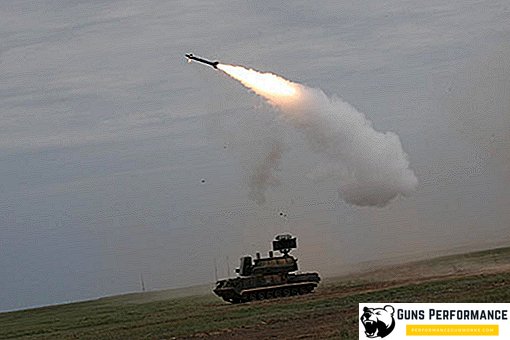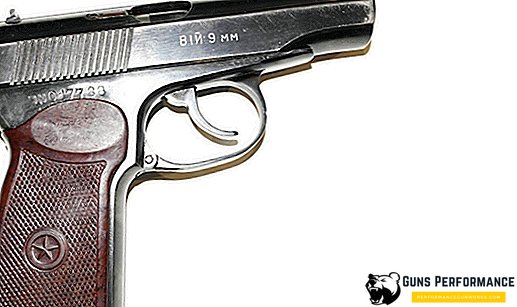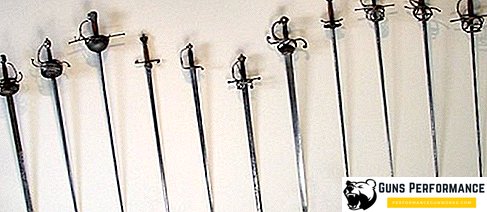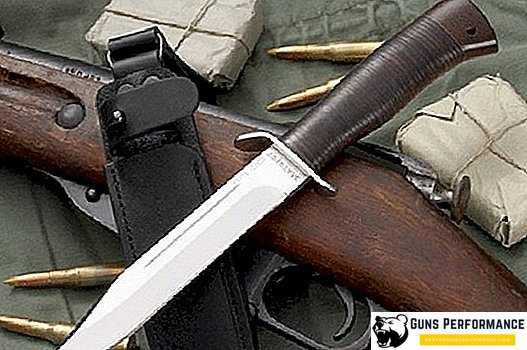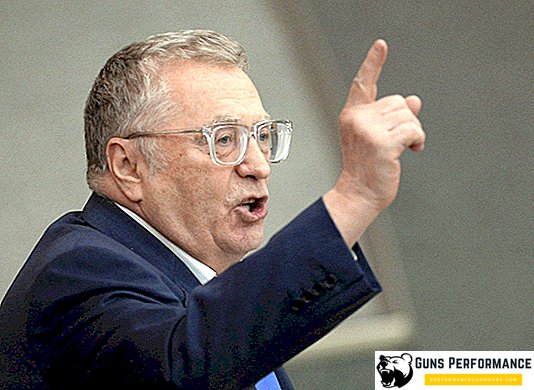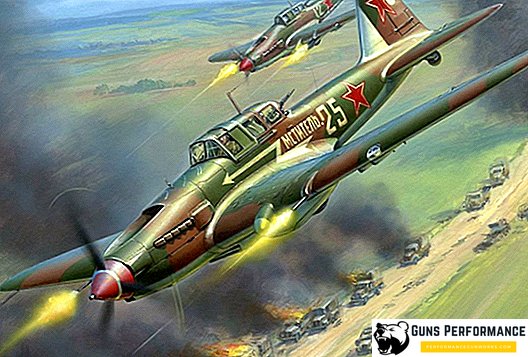
The IL-2 is a Soviet armored attack aircraft of the period of the Second World War, developed in OKB-40 under the leadership of General Designer Sergey Ilyushin. The Il-2 is the most massive combat aircraft in the history of aviation: during mass production, Soviet industry produced more than 36 thousand of these machines.
IL-2 attack aircraft participated in all major battles on the Soviet-German front, as well as in the war against imperial Japan. Serial production of the aircraft began in February 1941 and lasted until 1945. After the war, the IL-2 was in service with the air forces of Poland, Bulgaria, Yugoslavia and Czechoslovakia. Operation of the aircraft continued until 1954. During the war, more than ten modifications of the IL-2 were developed.
This combat vehicle has long become a legend and a true symbol of victory. However, the IL-2 can be called one of the most controversial combat vehicles of the Great Patriotic War. Disputes around this plane, its strengths and weaknesses, do not subside to this day.
In the Soviet period, numerous myths were created around the aircraft, which had little to do with the real history of its use. The public was told about a heavy armored plane, invulnerable to fire from the ground, but practically defenseless against enemy fighters. About the "flying tank" (this name was invented by Ilyushin himself), armed with erasami, for which the enemy armor was like seeds.
After the collapse of the USSR, the pendulum swung in the other direction. They talked about the low maneuverability of the attack aircraft, about its low flight performance, about the enormous losses suffered by the attack aircraft during the entire war. And about the air arrows IL-2, often recruited from the penal battalions.
Much of the above is true. However, it should be noted that the Il-2 attack aircraft was the most effective battlefield aircraft that the Red Army had at its disposal. There was nothing better in her arsenal. It is simply unrealistic to overestimate the contribution that the Il-2 attack aircraft made to the victory over the Nazis, so great and significant it is. Only a few numbers can be cited: by the middle of 1943 (the beginning of the Battle of Kursk), Soviet industry sent 1,000 IL-2 planes to the front each month. These combat vehicles accounted for 30% of the total number of combat aircraft that fought at the front.
IL-2 pilots died much more often than fighter pilots or bomber pilots. For 30 successful sorties on the IL-2 (at the beginning of the war) at the beginning of the war, the pilot was awarded the title Hero of the Soviet Union.
The Il-2 attack plane was the main Soviet aircraft to support the troops; it smashed the enemy even in the hardest first months of the war, when the German aces were fully in charge of our skies. The IL-2 is a real front-line aircraft, a worker-plane, which carried all the difficulties of the war on its shoulders.

History of creation
The idea of creating a specialized aircraft that would strike at the front line of the enemy’s defense and the front-line zone arose almost immediately after the appearance of combat aircraft. However, at the same time, the problem of protecting such vehicles and their crews from fire from the ground arose. Assault aircraft usually operate at low altitudes, and fire on it is carried out from everything that is at hand: from pistols to anti-aircraft guns.
The pilots of the first aircraft had to improvise: to put pieces of armor, sheets of metal, or even frying pans under the seats.
The first attempts to create armored aircraft belong to the period of the end of the First World War. However, the quality and power of aircraft engines of that time did not allow making a reliably protected aircraft.
In the post-war period, interest in combat vehicles attacking (storming) the enemy’s battle formations declined slightly. The priority was huge aircraft of strategic aviation, capable of "breaking out" the enemy from the war, destroying its cities and military factories. Only a few countries continued to develop aircraft that directly support the troops. Among them was the Soviet Union.
In the USSR, not only continued to develop new attack aircraft, but also worked on a theoretical justification for the use of such machines on the battlefield. Assault aviation was assigned a significant role in the new military concept of the deep operation, which was developed by Triandafilov, Tukhachevsky and Egorov at the turn of the 1920s and 1930s.
Along with theoretical investigations, work was in full swing at numerous aviation design bureaus. The projects of the Soviet attack aircraft of that time fully reflected the views of domestic military experts on the role of this type of aircraft and the tactics of its use. At the beginning of the 1930s, the development of two cars began at once: a heavy armored attack aircraft of the TSH-B (he was engaged in Tupolev) and a light aircraft of the LSh, which was worked on in the Menzhinsky Design Bureau.

TSH-B was a heavy twin-engined armored aircraft with four crew members and very powerful cannon-bomb armament. They even planned to install a recoilless 76 mm caliber cannon on it. It was intended to destroy important and well-protected enemy targets behind the front line. The mass of armor protection TSH-B reached one ton.
The light attack aircraft (LS) had a single-engine biplane scheme, practically without armor, its armament consisted of four mobile machine guns.
However, the Soviet industry was not able to embody any of the projects described in the metal. The experience of designing armored attack aircraft was useful during the development of the prototype aircraft TSH-3, which was a monoplane with armor protection, which was part of the power circuit of the machine. The aircraft designer Kocherigin was involved in this project, so he (and not Ilyushin) could be called the creator of the attack aircraft with carrier armor.
However, TSH-3 was a very mediocre aircraft. His fuselage was made of angular armor plates connected by welding. That is why the aerodynamic characteristics of the TSH-3 left much to be desired. Model tests were completed in 1934.
In the West, the idea of creating an armored attack aircraft was abandoned altogether, believing that divers could perform its functions on the battlefield.
At the same time, work on the creation of a new armored attack aircraft on the initiative was carried out in the Ilyushin Design Bureau. In those years, Ilyushin was not only engaged in the creation of new aircraft, but also headed the Commander-in-Chief of the aviation industry. At his disposal, the Soviet metallurgists have developed a technology of double-curvature aviation armor, which made it possible to design aircraft of optimal aerodynamic shape.

Ilyushin appealed to the country's leadership with a letter in which he pointed out the need to create a highly secure attack aircraft and promised to create such a machine as soon as possible. By this time, the project of the new attack aircraft from the designers was almost ready.
Ilyushin's voice was heard. He was ordered in the shortest possible time to create a new car. The first prototype of the future "flying tank" rose to the sky on October 2, 1939. It was a double monoplane with a water-cooled engine, a semi-retractable landing gear and armor protection included in the aircraft’s power circuit. The armor protected the cockpit of the pilot and the arrow navigator, the power plant and the cooling system - the most important and vulnerable elements of the machine. The prototype was called the BS-2.

The water cooling engine was not very suitable for attack aircraft. A single bullet or fragment is enough to damage the radiator, and as a result, the engine will simply overheat and stop working. Ilyushin found an extraordinary solution to this problem: he placed the radiator inside the air tunnel located in the aircraft’s armored hull. On the plane were used and other technological innovations. However, despite all the tricks of the designers, the BS-2 did not reach the characteristics specified in the terms of reference.
The attack aircraft had insufficient speed and range, and his longitudinal stability was not all normal. Therefore, Ilyushin had to rework the plane. From a two-seater, he turned into a single: the cabin arrow-navigator was eliminated, and instead it installed another fuel tank. The BS-2 became lighter (the armored hull was reduced), thanks to the additional fuel supply, its range increased.

After the war, Ilyushin repeatedly said that the top leadership of the country forced him to abandon the rear arrow, and he himself protested against such a decision. Depending on the political situation, the initiator of this measure was either Stalin himself or some abstract "military". It is likely that in this case Sergey Vladimirovich was somewhat cunning, because the attack aircraft had to be redone in order to improve its technical characteristics. Otherwise, he simply would not be accepted.
Moreover, in the technical assignment a double aircraft was originally indicated, the commissariats learned about the remake of the car at the last moment.
In the course of modernization, a more powerful AM-38 engine was installed on the BS-2, the nose part of the fuselage was slightly extended, and the wing area and stabilizers increased. The cockpit was somewhat elevated (for which he received the nickname "Humpback"), which provided the best forward-down view. In the fall of 1940, the tests of a modernized single BS-2 began.
Serial production of the aircraft began in February 1941 at the Voronezh Aviation Plant. In November 1941, he was evacuated to Kuibyshev. A certain amount of IL-2 was manufactured at the Aviation Plants No. 30 in Moscow and No. 381 in Leningrad.
So, the Soviet Union launched a war with a single Il-2 attack aircraft without an air gunner, which provided protection for the rear hemisphere. Was Ilyushin right when launching such a plane into the series? Such a decision cost the lives of thousands of pilots. However, on the other hand, if the plane did not meet the necessary requirements, it would not be launched at all in the series.

Aircraft structure
The IL-2 is a single-engine low-wing aircraft, the glider of which has a mixed wooden-metal structure. The main feature of the IL-2 is the inclusion of armor protection in the power circuit of the aircraft. It replaces the skin and frame of the entire front and center of the machine.
Armored housing provided protection for the engine, cabin, radiator. On the prototype IL-2, the armor also covered the rear arrow, located behind the pilot. In front, the pilot was protected by a transparent armor visor, which withstands a hit of 7.62 mm bullets.

The armored part of the fuselage ended immediately behind the cockpit, and the back of the IL-2 consisted of 16 frames (metal or wooden), covered with birch veneer. The plumage of the attack was mixed: it consisted of a wooden keel and metal horizontal stabilizers.
Faced with heavy losses in the initial period of the war, the Air Force leadership again demanded that the attack aircraft be redone into a double. This modernization could be carried out only by the end of 1942. But already in the first months of the war, an improvised place for an air gunner began to be equipped in its units with its own forces in Ilakh. Often they became mechanics.
However, it was already impossible to place the arrow inside the armored hull, for this it was necessary to completely redo the aircraft fuselage. Therefore, the shooter was protected only by a 6-mm sheet of armor from the tail, there was no protection at all from below and from the sides. The shooter didn’t even have his own seat - it was replaced by an uncomfortable canvas strap. The 12.7-mm UBT machine gun in the rear cockpit was not the most reliable protection against fighters - but still it is better than nothing at all.
The place of the gunner on the IL-2 was often called the "cabin of death". According to statistics, there were seven gunners per one killed attack pilot. Often for this work attracted pilots from penal companies and battalions.
The wing of the IL-2 consisted of a center section and two consoles, made of wood and sheathed with plywood. The wing of the plane had flaps and ailerons. In the center section of the attack aircraft there was a bomb bay and niches in which the main landing gear was removed. In the wing of the IL-2 also housed cannon-machine gun aircraft.

IL-2 had a three-bearing chassis, consisting of the main struts and the tail wheel.
Attack aircraft equipped with a 12-cylinder water-cooled engine AM-38 with a V-shaped camber of cylinders. Its capacity ranged from 1620 to 1720 liters. with.
The pneumatic system provided the engine start, the flaps and the landing gear. In an emergency, the chassis could be released manually.
A typical double IL-2 armament consisted of two Shkas 7.62 mm machine guns (750-1000 rounds of ammunition for each) and two 23-mm VYa-23 cannons (for each gun 300-360 rounds) mounted inside the wing, and one UBT defensive machine gun (12.7 mm) in the cockpit arrow.
The maximum combat load of the IL-2 was 600 kg, on average it was possible to load up to 400 kg of bombs and missiles or containers for the PTAB on the aircraft.

Combat use: advantages and disadvantages of IL-2
The usual tactic of using the IL-2 was an attack from a gentle dive or firing at the enemy on a low level flight. Planes lined up in a circle and in turn went to the target. Most often, IL-2 was used to strike at the front lines of the enemy, which is often called a mistake. The equipment and manpower of the enemy on the front line were well covered, camouflaged and securely covered by anti-aircraft fire, therefore the results of the assault strikes were minimal and the losses of the aircraft were high. Much more effectively Il-2 ground attack aircraft operated against enemy convoys and objects in the near rear, artillery batteries, and troop congestion at crossings.

The Il-2 attack plane began to enter the army several months before the start of the war, and at the time of the outbreak of hostilities, this aircraft was new and poorly understood. There were no instructions for its use, they just did not have time to prepare. In the first months of the war, the situation became even worse. In the Red Army, traditionally, little attention was paid to training pilots, and during the war period, the training period of the ground attack pilots was generally reduced to 10 hours of flight time. Naturally, during this time it is impossible to train a future air fighter. To understand how difficult the first months of the war were for assault aircraft, one can cite only one: until the end of the autumn of 1941 (December 1), 1,100 vehicles were lost from 1,400 IL-2s.
At the beginning of the war, the IL-2 suffered such losses that flights were compared with suicide. It was during this period that the order of Stalin appeared on awarding the pilots of attack aircraft with the star of the Hero of the Soviet Union for ten successful sorties on the Il-2 - an unprecedented event in the history of the Great Patriotic War.

The very high losses among the IL-2 aircraft at the beginning of the war are usually attributed to the absence of the rear gunner, which made the aircraft virtually defenseless against fighter attacks. However, the main reason was the almost complete absence of fighter cover, numerous design flaws in the aircraft itself and the low qualifications of the flight personnel. By the way, IL-2 losses from anti-aircraft fire were higher than from the actions of enemy fighters. The main cause of losses was the relatively low speed of the aircraft and its low ceiling.
Although the IL-2 is called a “flying tank,” its armored corps reliably protected only against 7.62 mm bullets. Anti-aircraft shells easily punched him. The attacker's wooden tail could easily have been cut off by a successful machine-gun burst.
IL-2 was quite easy to control, but its maneuverability left much to be desired. Therefore, he could not count on passive defense in a collision with an enemy fighter. In addition, the review from the cockpit was unsatisfactory (especially back), and often the pilot simply did not see the enemy approaching in the rear hemisphere.

Another serious problem of the initial period of the war was the low build quality of domestic aircraft. The first batch of workers and equipment of the Voronezh aircraft factory arrived in Kuibyshev on November 19. In harsh conditions, working in two shifts for 12 hours, in cold weather, sometimes reaching 40 degrees, in the unfinished workshops began mass production of attack aircraft. There was no water, sewage, there was an acute shortage of food. It is difficult for modern man to imagine such a thing. In addition, only 8% of workers were adult males, the rest were women and children.
Not surprisingly, the quality of the first cars was low. Arriving at the front of the aircraft, the planes were preliminarily modified (and often repaired) and then flown around. However, their mass production was launched as soon as possible. Heads of aircraft factories at that time were more interested in the number of aircraft than their quality.
В этом отношении показательна телеграмма Сталина от 23 декабря 1941 года, которая была отправлена директору завода Шекману: "… Самолеты Ил-2 нужны нашей Красной Армии теперь как воздух, как хлеб. Шекман дает по одному Ил-2 в день… Это насмешка над страной, над Красной армией. Прошу Вас не выводить правительство из терпения и требую, чтобы выпускали побольше Илов. Предупреждаю в последний раз. СТАЛИН". Мало кто тогда осмеливался спорить с Вождем, и в январе следующего года завод сумел изготовить уже 100 самолетов.
К недостаткам Ил-2 можно также отнести несовершенный и неудобный бомбоприцел. Позже он был снят, а бомбометание проводилось с помощью рисок, нанесенных на носовой части фюзеляжа. Сказывалось на потерях и эффективности штурмовиков и отсутствие до середины войны на большинстве машин радиостанций (не лучше дело обстояло и на других типах советских самолетов). Ситуация начала выправляться только в конце 1943 года.
Наименее эффективным из вооружения штурмовика оказались подвесные бомбы. Немного лучше зарекомендовали себя реактивные снаряды ("эрэсы"). В начале войны прекрасно показали себя специальные капсулы с белым фосфором, которые сбрасывали на бронетехнику противника. Однако фосфор был очень неудобен в использовании, поэтому вскоре от его применения отказались. В 1943 году штурмовики Ил-2 получили на вооружение противотанковые авиабомбы ПТАБ, которые имели кумулятивную БЧ.
Вообще, следует отметить, что Ил-2 оказался не слишком хорошим "противотанковым" самолетом. Гораздо успешнее штурмовик работал против небронированной техники и живой силы противника.
Всего за годы войны было потеряно 23,6 тыс. штурмовиков Ил-2. Удивляет огромный процент небоевых потерь: только 12,4 тыс. самолетов Ил-2 были сбиты противником. Это еще раз демонстрирует уровень подготовки летного состава штурмовой авиации.
Если в начале войны количество штурмовиков к общему числу самолетов фронтовой авиации РККА составляло всего 0,2%, то к осени следующего года оно увеличилось до 31%. Такое соотношение сохранялось до самого конца войны.
Ил-2 применялся не только для уничтожения наземных объектов, довольно активно он использовался и для атак против надводных кораблей противника. Чаще всего пилоты Ил-2 использовали топмачтовое бомбометание.

Specifications
- экипаж - 2 чел;
- двигатель - АМ-38Ф;
- мощность - 1720 л. с.;
- размах/площадь крыла - 14,6 м/38,5 м2;
- длина самолета - 11,65 м.;
- масса: макс. взлетная/пустого - 6160/4625кг;
- Max. скорость - 405 км/ч;
- практический потолок - 5440 м;
- Max. дальность - 720 км;
- вооружение - 2×ШКАС (7,62 мм), 2×ВЯ (23 мм), УТБ (12,7 мм).
Характеристики модели 1942 года

- Годы изготовления: 1942-1945.
- Всего изготовлено: около 36 тысяч (всех модификаций).
- Экипаж - 2 человека.
- Взлетная масса - 6,3 т.
- Длина - 11,6 м, высота - 4,2 м, размах крыла - 14,6 м.
- Вооружение: 2х23-мм пушки, 3х7,62-мм пулемета, точки подвески для авиабомб, РС-82, РС-132.
- Максимальная скорость - 414 км/ч.
- Практический потолок - 5,5 км.
- Дальность полета - 720 км.




